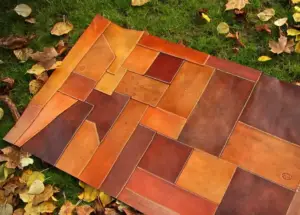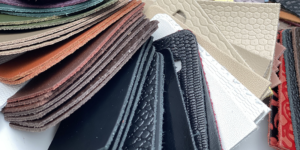Can you use wood stain on leather? (Read this FIRST!)
If you are like me, you’ve probably experimented with several things to add color to your leather crafts.
I have tried brewed coffee, darkening oils, and even household products like vinegar. A while ago I discovered that you can also use wood stain on leather. However, there seems to be a lot of debate regarding this.
So to answer this question, we’ll dedicate this article to talking about the pros and cons of using wood stain on leather. And if you decide to use it, you will find a few tips on how you can use it safely to stain your leather items.

Can you use wood stain on leather?
Yes, you can use wood stain on leather to get a new look. Leather sucks up the wood stain just fine and may not bleed or rub off against other surfaces. However, wood stain differs significantly from the actual leather stain so the outcome might be a little different from what you expect.
Here are some of the benefits of using wood stain on leather items.
-
Deeper and darker color
As we have always said, unfinished leather is porous so it will absorb the stain easily. This will definitely result in a more intense color on leather than it would appear on wood.
-
Wide range of colors
Wood stains come in a wide range of colors compared to leather dye. So you will be able to stain your leather with whichever color you want to create your unique leather crafts.
-
Oil-based wood stain protects leather
Oil-based wood stain adds a protective seal on the surface of the leather, which makes it water resistant. For instance, when rained on, water just beads on the surface of the leather instead of soaking in.
Additionally, some oil-based wood stains are resistant to UV rays and protect the leather from fading when exposed to sunlight over a long time.
How to stain leather with wood stain
Step 1: Choose a wood stain
Get a highly recommended wood stain like Minwax oil-based wood stain.
It is advisable to use an oil-based wood stain instead of a latex-based one because it provides better protection against moisture. Also, it is good at hiding imperfections and flaws which are quite common on natural leather.
Step 2: Clean the leather item
First, you need to clean your leather and then strip off the finish on the surface to allow it to absorb the stain.
Start by degreasing your item to get rid of grease, grime, and dirt on the surface, and then go in with a leather refinisher to remove the finish.
Formbys is a good leather refinisher that easily dissolves the varnish or lacquer so you don’t have to sand or scrape it off.
Once all the finish is off, wipe the leather surface using a clean and damp cloth to get rid of any residue.
Step 3: Brush wood stain leather
In the third step, you need to apply the wood stain generously on the leather using a dry cloth.
Rub it in a circular motion so that it penetrates deep into the leather pores to prevent rubbing off once it dries.
Step 4: Dry and buff
Leave the leather item to dry for at least 24 hours or overnight before buffing it with a soft and clean cloth to get a nice shine.
Step 5: Apply sealant
Just because leather has been stained or dyed doesn’t mean that it is no longer porous.
If left unsealed, stained leather can still absorb water or spilled liquids. So, you need to seal it once it’s dry and well-buffed.
Consider using Resolene or its alternatives to finish the leather and protect it from moisture or water damage. You should also paint the edges of the leather to protect it from damage.
Cons of using wood stain on leather
While you may get the desired results with wood stain, it’s important that we mention some disadvantages of using it on leather furniture or clothing.
As mentioned earlier, leather will readily absorb the stain since it’s porous. However, it might absorb too much of it and require you to use more stain than you would if you used a specialized leather stain or dye. This will definitely cost you more.
Additionally, your light-colored leather items might become darker. If this was not your desired outcome, then your item will be ruined.
Also, watch out for possible stiffening or hardening of leather when you use wood stain instead of leather stain.
Wood stain gets deep into the leather pores and it might strip off the natural oils that make leather flexible. Also, it forms a barrier on the surface that might cause the leather to dry out and become brittle if it is not conditioned or moisturized often.
Conclusion
Some people argue that wood stain is specially formulated to dye wood and it can cause irreparable damage if used on leather. Others feel that it is as effective as any leather dye.
In my view, wood stain is safe to use on leather. You will like how it gives the leather a darker color and the wide range of colors you can pick from.
If you are worried about the best wood stain to use, my personal recommendation that won’t disappoint you is Minwax wood stain. But, I fully understand if you prefer to use the actual leather stain or dye instead, in which case I’ve written an entire buyer’s guide about it here.





